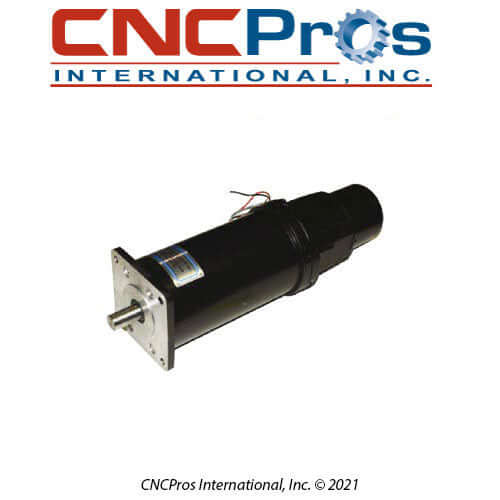MTR-0010 GLENTEK GM6000 SERIES DC SERVO MOTOR
MTR-0010 GLENTEK GM6000 SERIES DC SERVO MOTOR
Couldn't load pickup availability
Share

MTR-0010 GLENTEK GM6000 SERIES DC SERVO MOTOR. 6 BRUSHES
MTR-0010 GLENTEK GM6000 SERIES DC SERVO MOTOR. 6 BRUSHES
Production Features
Fadal Glentek DC Axis Motor GM6060-50 (MTR-0010)
INSTALLATION INSTRUCTIONS & TUNING
The Glentek GM6060-50, or MTR-0010, is a high-performance DC brush motor designed for the XYZ axes of Fadal VMC models with Box or Linear Ways. This motor is a direct replacement for both original Baldor and Glentek motors and is specifically engineered for machines using a metric pitch ball screw with a rapid traverse of 400-900 ipm.
The GM6000 series motors feature a cost-effective design with traditional ferrite magnets. Their higher inertia armatures are optimized for medium to high inertia loads, significantly reducing vibrations and enhancing stability. A key technical feature is the skewed armature, which ensures ultra-smooth operation at all speeds by minimizing torque fluctuations.
Technical Specifications
Brand: Glentek
Motor Type: DC Brush, Permanent Magnet
Dimensions (W x H x D): 30.48 cm x 33.02 cm x 60.96 cm
Weight: 19.50 kg
Why Choose CNCPros?
When you need a replacement motor, CNCPros is your trusted source for high-quality, reliable solutions. We go beyond simply providing a part; we offer a comprehensive support system designed to ensure your machine's stability and reliability.
- Expert Advice: Our experienced professionals are available to help you diagnose the issue and confirm that the MTR-0010 is the correct motor for your specific application. Our profound knowledge of Fadal motor systems ensures you make the right purchasing decision.
- Dedicated Support: We offer unwavering support both during and after installation. Our team has extensive experience in motor technology and maintains direct connections with supplier engineers, guaranteeing you receive top-notch assistance.
- One-Year Limited Warranty: Your investment is protected by a One-Year Limited Warranty, which covers repairs or replacements for a full year.
- Comprehensive Documentation: We provide user-friendly, step-by-step manuals that simplify the installation process and offer practical insights for long-term maintenance.
- Rapid Response: We are committed to minimizing your machine's downtime. Our team provides quick and efficient support to address any issues promptly and keep your operations running smoothly.
Troubleshooting
Systematic Diagnosis of Fadal DC Servo Motor Overload Conditions
A motor overload alarm indicates a critical fault within the machine's motion control system. Our systematic diagnostic approach is designed to simplify this complex issue, guiding you to a definitive root cause analysis.
Based on extensive service data, we have identified four primary failure modes that account for over 95% of all DC servo motor overload conditions.
Internal Motor Component Failure:
This is the most frequent cause, accounting for approximately 70% of all overload alarms. An internal motor fault can manifest as:
- Commutator and Brush Issues: Shorting between the main brushes and the commutator.
- Tachometer Failure: A compromised tachometer or its brushes resulting in a loss of velocity feedback.
- Armature Faults: Shorted armature windings leading to a current surge.
- Magnet Demagnetization: Loose or weakened magnets compromising the motor's magnetic field.
- Resolver Signal Degradation: An internal resolver fault leading to a loss of position feedback integrity.
Wiring and Cable Harness Integrity: This can be a more challenging issue to diagnose. While relatively rare on the static Y and Z axes, the X-axis cable harness is highly susceptible to wear. Over time, constant motion and exposure to coolant can compromise cable insulation, leading to inter-wire shorts or ground faults that stress the servo amplifier.
Power Amplifier Malfunction: The servo amplifier is a common source of failure, responsible for approximately 25% of overload issues. To isolate a faulty amplifier, perform a methodical cross-axis validation. By swapping the suspect amplifier with a known good one from another axis (excluding the 4th axis), you can determine if the fault remains with the axis or follows the amplifier.
Control Card Fault: Though less common, a faulty controller card can also be a root cause. The axis controller cards, labeled 9, 10, and 11 for X, Y, and Z respectively, can be swapped with each other to verify their status. No jumper or EPROM changes are required for this diagnostic procedure.
For a data-driven approach, the motor itself is the most probable cause (70%). You can perform a cross-axis motor swap to confirm if the fault follows the motor. The servo amplifier is the next most likely culprit (25%), while axis controller cards fail infrequently.
Diagnostic LED Guide:
- 1010-5 and Earlier: A properly functioning card will have a steady red, blinking light at the top.
- 1010-6: A small green LED indicates nominal operation. An amber LED typically signals an external fault (e.g., motor resolver or encoder issue), while a red LED indicates a card internal failure.
We understand the critical importance of minimizing machine downtime. Our technical support team is available to assist you with any stage of this diagnostic process or to provide professional confirmation of your findings. Please do not hesitate to contact us at 208-888-9236.
Thanks!
